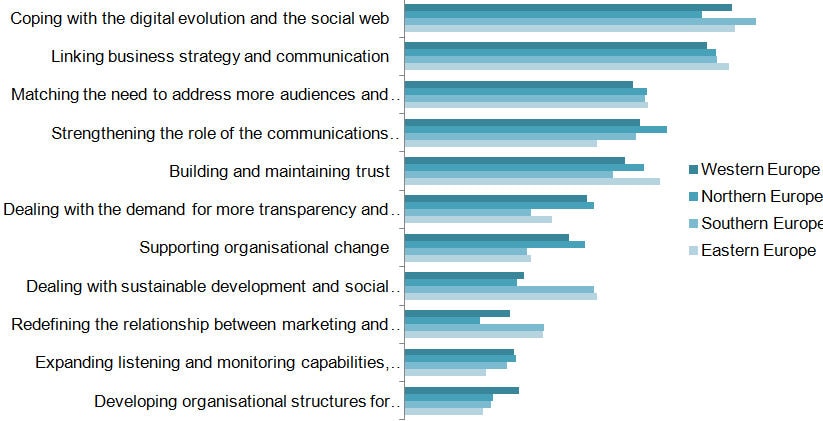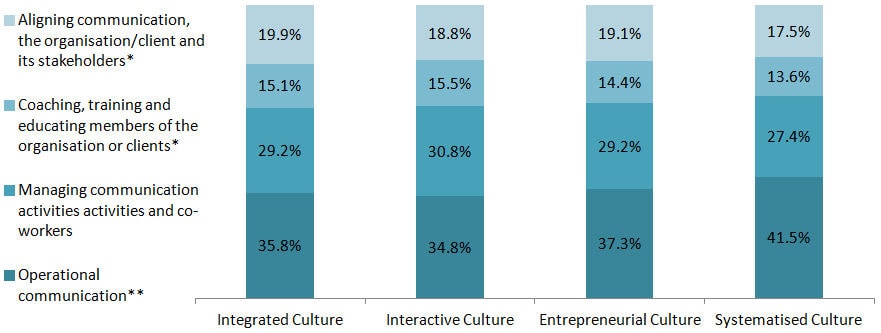According to the latest annual study into trends of communication management across Europe, the European Communication Monitor 2012, there is a large gap between the perceived importance of social media tools for communication and the actual rate of implementation in European organisations
Ralph Tench, professor of PR and communication at Leeds Metropolitan University, illustrates this by saying that despite mobile applications entering the top three ranks of important social media platforms, the backlog of implementation is higher than in any other field.
Most important strategic issues (three picks per respondent)

Source: The European Communication Monitor 2012
Describing how the findings show a disparity between appreciating the importance of online media and actually using it, Tench says: “Online communities or social networks are considered by far the most important social media tool available. With more than 75 per cent support by respondents, they are leading the list of important social media tools, followed by online videos (67 per cent), mobile applications like apps and mobile webs (65 per cent), micro blogs like Twitter (56 per cent) and weblogs (45 per cent). However, less than 56 per cent of the communication departments actually use online communities in their communication. A gap of more than 20 per cent compared to the importance this tool is given by practitioners. The biggest difference between importance (65 per cent) and implementation (31 per cent) is found for mobile applications, a gap of almost 35 points.”
Tench adds that the report shows that mobile applications, weblogs and photo sharing are considered the most important opportunities in social media communication. However, he adds that all communication managers report rather moderate skills for using digital technologies for internal and external communication, regardless of their gender. What is surprising is that despite this, only every second respondent thinks that training is useful. Perhaps this is because informal approaches to enhance those skills are favoured. Tench explains: “Eight out of ten European professionals think that the best way to learn about online tools is to use them as part of the regular work as well as privately. Although social media has been much discussed in the profession for many years only two channels (online communities and online videos) are rated as very important or at least as important by a majority of the respondents.”
Productive time spent at work

Source: The European Communication Monitor 2012
In conclusion, Tench believes the report shows there is a long way to go before European PROs have fully got to grips with using digital, but they are striving to do so: “Evaluating the potential of social media and investing in platforms and digital competencies will most likely remain at the top of the agenda for communication professionals. In practice, communicators in Europe are having to adapt to new structures, strategies and tactics as well as to have more courage to guide the change. This can be high-risk way of working, but it is also the path to a more advanced vision for the profession and those who lead it.”
Background
The annual European Communication Monitor was held for the sixth time in a row this year. It is the most comprehensive empirical survey of communication management worldwide with 2,185 participating professionals from 42 countries in 2012. The research is conducted by a group of professors from 11 universities across Europe within the framework of the European Public Relations Education and Research Association (EUPRERA). Partners include the European Association of Communication Directors (EACD) and Communication Director Magazine, as well as PR firm Ketchum Pleon, which sponsors the project from this year onwards. A look at the demographics shows that 71.7 per cent of the respondents work on the first or second level of the communication hierarchy as heads of communication, unit leaders or agency CEOs. While this article reports on the overall trends, detailed analyses for various groups can be found in the full report available at www.communicationmonitor.eu.
PR Masterclass: The Agency Growth Forum
Our experts will each give you a 20-minute Masterclass on what we've identified as the 11 most important elements in running a modern, profitable and successful PR firm.
Taking place on Wednesday 26th November in London, both virtual and in person tickets are available.
Tickets on sale now!
PR MasterclassIf you enjoyed this article, sign up for free to our twice weekly editorial alert.
We have six email alerts in total - covering ESG, internal comms, PR jobs and events. Enter your email address below to find out more:








